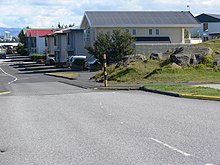Erla Stefánsdóttir
Erla Stefánsdóttir (* December 6, 1935 - October 5, 2015 in Iceland ) was an Icelandic piano teacher, author and, according to her own statements, a medium and specialist on the subject of Huldufólk ("Hidden People", which includes elves and trolls ). The now widespread term Elfenbeauftragte goes back to an expression first coined by the author and artist Wolfgang Müller in the year-end edition (December 30, 1995) of the Frankfurter Rundschau ; it does not correspond to a permanent official function in Iceland.
background
It is part of the Icelandic building permit process to check whether a building project has damaged cultural property . The cultural assets also include terrain formations such as large stones or rocks, which in Icelandic folklore are considered "inhabited by elves". This can be the case if, for example, there are old fairy tales or stories that assume this. In such cases, an external appraisal will be obtained from a person who is considered to be eleven. This group of people included Erla Stefánsdóttir, who, according to her own statements, was clairvoyant (isl. Skyggn ). It has been commissioned from time to time - by the city of Reykjavík , by building authorities in other cities and by private individuals - to prepare such reports. However, she was not a full-time expert on the subject of Huldufólk and there is no official function for it.
Depending on the spatial conditions, a planned section of road can be modified as a result of such reports and certain rocks are not affected by construction measures. Probably the best known case of a road narrowing due to an "elven rock" is the Álfhólsvegur ("elven hill path ") in Kópavogur. There is a narrow street in front of house no. 125 because such a rock protrudes into the roadway. Another example can be found in the town of Grundarfjörður : between houses no.82 and no.86 on the main street is a large rock that takes up the space of house number 84.
Erla Stefánsdóttir also occupied himself with observing, recording and cataloging the occurrence of light fairies , gnomes and trolls. The places where the medium suspected subtle spirits are cataloged in their foldable “elf maps” of Ísafjarðarbær and Hafnarfjörður and marked with legends. She also gave advice on how and whether there could and should be built there. In 2004 Erla Stefánsdóttir published an extensive book in Icelandic that contained her collected elven knowledge.
The full-time piano teacher subsequently became known in Germany, especially through the German media, through the term "Elfenbeauftragte" constructed by Wolfgang Müller, which he added as number 599 to his catalog raisonné. Müller's interview and lectures about Iceland have made the piano teacher very popular. In autumn 2007, Erla's wisdoms were published for the first time in German under the title “Lífssýn mín - Life Insights of the Icelandic Elven Commissioners” in a relevant publishing house.
In his book News from the Elf Front - The Truth About Iceland , Müller describes in the saga of the Elf Commissioner the story of how the German media created and describes an "Elf Minister" out of pure sensationalism, inspired by Erla's statement: " There are elves everywhere - also in Berlin! ”An unusual route diversion because of“ certain occurrences ”on the S-Bahn in Berlin in text and images.
Works
- Lífssýn mín. Reykjavík 2003, ISBN 9979-60-901-X .
- German translation: Lífssýn mín : Insights into life of the Icelandic elven commissioner. translated by Hiltrud Hildur Guðmundsdóttir. Neue Erde, Saarbrücken 2007, ISBN 978-3-89060-264-6 .
- Örsögur. Sigrún Lilja, 2010, ISBN 978-9979-70-735-6 .
- Erlas fairy stories: the "Icelandic fairy commissioner" tells. translated by Hiltrud Hildur Guðmundsdóttir. Neue Erde, Saarbrücken 2011, ISBN 978-3-89060-593-7 .
Web links
Individual evidence
- ^ Andy Jarosz: Iceland: Huldufólk | National Geographic Traveler (UK). In: www.natgeotraveller.co.uk. 2012, accessed September 28, 2015 .
- ^ Kurt Marti, Hektor Leibundgut, Klaus Bäumlin: Notes and Details 1964–2007: Articles from the magazine [sic] Reformatio . Theologischer Verlag Zürich, 2010, ISBN 978-3-290-17541-2 ( limited preview in Google book search [accessed September 28, 2015]).
| personal data | |
|---|---|
| SURNAME | Erla Stefánsdóttir |
| BRIEF DESCRIPTION | Icelandic piano teacher, writer, elven specialist and medium |
| DATE OF BIRTH | December 6, 1935 |
| PLACE OF BIRTH | Iceland |
| DATE OF DEATH | 5th October 2015 |
| Place of death | Iceland |
